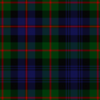Scottish Yeomanry
| The Scottish Yeomanry | |
|---|---|
 Cap Badge of The Scottish Yeomanry | |
| Active | 1992-1999 |
| Country | |
| Branch | |
| Type | Yeomanry |
| Role | Light reconnaissance |
| Size | One Regiment |
| Part of | Royal Armoured Corps |
| Regimental Headquarters | Inchdrewer House |
| Motto(s) | All seeing |
| March | The Garb of Old Gaul |
| Vehicles | Land Rover Defender |
| Commanders | |
| Honorary Colonel 1992-97 | Lieutenant General Sir Norman Arthur KCB JP[1] |
| Honorary Colonel 1997-99 | Brigadier Melville Jameson CBE DL[2] |
| Insignia | |
| Abbreviation | SCOTS YEO |
| Stable Belt Colours[3] |  |
| Regimental Tartan (Murray of Atholl)[4] |  |
| Tartan | Murray of Atholl |
The Scottish Yeomanry (SCOTS YEO) was a Yeomanry Regiment of the British Territorial Army formed in 1992. It was disbanded in 1999.
History
The Scottish Yeomanry was raised on 1 November 1992 as a result of Options for Change with headquarters at Inchdrewer House, Colinton Road, Edinburgh by transfer and resuscitation of old regiments as squadrons.[5] The regiment consisted of a headquarters and three sabre squadrons:
- "HQ" (Lothians and Border Horse) Squadron (Edinburgh) was formed by the re-roling of 225 Squadron, 154 (Lowland) Regiment Royal Corps of Transport.[6]
- "A" (Ayrshire (Earl of Carrick's Own) Yeomanry) Squadron (Ayr) was transferred into the new regiment from the QOY where they had been serving on both CVR(W) Fox and other CVR(T) variants.[6]
- "B" (Lanarkshire and Queen's Own Royal Glasgow Yeomanry) Squadron (East Kilbride) was formed by the re-roling of 222 Squadron, 154 (Lowland) Regiment Royal Corps of Transport.[6]
- "C" (Fife and Forfar Yeomanry/Scottish Horse) Squadron (Cupar) was formed by the re-roling of 239 (Highland Yeomanry) Squadron, 153 (Highland) Regiment Royal Corps of Transport. Until 1999 "C" Squadron also maintained part of the lineage of the Lovat Scouts.[6]
On 1 July 1999, following the Strategic Defence Review, elements were of the regiment ("A" and "C" Squadrons) were transferred to the Queen's Own Yeomanry.[7] "B" Squadron was re-roled to become 52 Squadron of 32 Signal Regiment and HQ Squadron and regimental headquarters disbanded.[5]
Uniform
The Scottish Yeomanry wore a grey beret of the Royal Scots Dragoon Guards bearing a cap badge of the regiment consisting of the Lion Rampant of Scotland upon crossed lances under the Scottish Crown.[8]
The officers and men of the regiment wore the Duke of Atholl's Tartan, Murray of Atholl, in various forms of dress.[9] The regimental stable belt which was adopted was a reversed version of the Ayrshire Yeomanry belt. This looked exactly like the 15th/19th The King's Royal Hussars' belt.[10]
References
- ^ "No. 53286". The London Gazette (Supplement). 26 April 1993. p. 7378. Although formally Gazetted in 1993, General Arthur had been performing this role since 1992.
- ^ "No. 55071". The London Gazette (Supplement). 16 March 1998. p. 3087. Although formally Gazetted in 1998, Brigadier Jameson had been performing this role since 1997
- ^ These stable belt colours originated from Ayrshire (Earl of Carrick's Own) Yeomanry
- ^ This tartan came from Fife and Forfar Yeomanry/Scottish Horse
- ^ a b "Scottish Yeomanry". Regiments.org. Archived from the original on 18 October 2007. Retrieved 18 November 2017.
{{cite web}}: CS1 maint: bot: original URL status unknown (link) - ^ a b c d "Lineage of Scottish Yeomanry". Retrieved 12 October 2016.
- ^ "Answer to Defence Review Questions". UK Parliament. 28 June 1999. Retrieved 18 November 2017.
- ^ "Scottish Yeomanry". Surplus and Outdoors. Retrieved 18 November 2017.
- ^ "The 8th Duke of Atholl". Clan Murray. Retrieved 18 November 2017.
- ^ "Scottish Yeomanry". Stable Belts. Retrieved 18 November 2017.
External links
- "Scottish Yeomanry". Regiments.org. Archived from the original on 18 October 2007. Retrieved 18 November 2017.
{{cite web}}: CS1 maint: bot: original URL status unknown (link)
